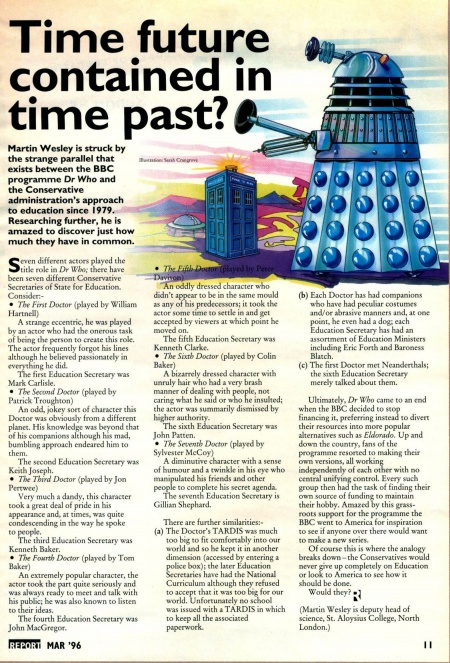Time future contained in time past?
- Publication: Report
- Date: March 1996
- Author: Martin Wesley
- Page: 11
- Language: English
Martin Wesley is struck by the strange parallel that exists between the BBC programme Dr Who and the Conservative administration's approach to education since 1979. Researching further, he is amazed to discover just how much they have in common.
Seven different actors played the title role in Dr Who; there have been seven different Conservative Secretaries of State for Education. Consider:-
- The First Doctor (played by William Hartnell)
A strange eccentric, he was played by an actor who had the onerous task of being the person to create this role. The actor frequently forgot his lines although he believed passionately in everything he did.
The first Education Secretary was Mark Carlisle.
- The Second Doctor (played by Patrick Troughton)
An odd, jokey sort of character this Doctor was obviously from a different planet. His knowledge was beyond that of his companions although his mad, bumbling approach endeared him to them.
The second Education Secretary was Keith Joseph.
- The Third Doctor (played by Jon Pertwee)
Very much a dandy, this character took a great deal of pride in his appearance and, at times, was quite condescending in the way he spoke to people.
The third Education Secretary was Kenneth Baker.
- The Fourth Doctor (played by Tom Baker)
An extremely popular character, the actor took the part quite seriously and was always ready to meet and talk with his public; he was also known to listen to their ideas.
The fourth Education Secretary was John MacGregor.
- The Fifth Doctor (played by Peter Davison)
An oddly dressed character who didn't appear to be in the same mould as any of his predecessors; it took the actor some time to settle in and get accepted by viewers at which point he moved on.
The fifth Education Secretary was Kenneth Clarke.
- The Sixth Doctor (played by Colin Baker)
A bizarrely dressed character with unruly hair who had a very brash manner of dealing with people, not caring what he said or who he insulted; the actor was summarily dismissed by higher authority.
The sixth Education Secretary was John Patten.
- The Seventh Doctor (played by Sylvester McCoy)
A diminutive character with a sense of humour and a twinkle in his eye who manipulated his friends and other people to complete his secret agenda.
The seventh Education Secretary is Gillian Shephard.
There are further similarities:-
(a) The Doctor's TARDIS was much too big to fit comfortably into our world and so he kept it in another dimension (accessed by entering a police box); the later Education Secretaries have had the National Curriculum although they refused to accept that it was too big for our world. Unfortunately no school was issued with a TARDIS in which to keep all the associated paperwork.
(b) Each Doctor has had companions who have had peculiar costumes and/or abrasive manners and, at one point, he even had a dog; each Education Secretary has had an assortment of Education Ministers including Eric Forth and Baroness Blatch.
(c) The first Doctor met Neanderthals; the sixth Education Secretary merely talked about them.
Ultimately, Dr Who came to an end when the BBC decided to stop financing it, preferring instead to divert their resources into more popular alternatives such as Eldorado. Up and down the country, fans of the programme resorted to making their own versions, all working independently of each other with no central unifying control. Every such group then had the task of finding their own source of funding to maintain their hobby. Amazed by this grassroots support for the programme the BBC went to America for inspiration to see if anyone over there would want to make a new series.
Of course this is where the analogy breaks down — the Conservatives would never give up completely on Education or look to America to see how it should be done.
Would they?
(Martin Wesley is deputy head of science, St. Aloysius College, North London.)
Disclaimer: These citations are created on-the-fly using primitive parsing techniques. You should double-check all citations. Send feedback to whovian@cuttingsarchive.org
- APA 6th ed.: Wesley, Martin (March 1996). Time future contained in time past?. Report p. 11.
- MLA 7th ed.: Wesley, Martin. "Time future contained in time past?." Report [add city] March 1996, 11. Print.
- Chicago 15th ed.: Wesley, Martin. "Time future contained in time past?." Report, edition, sec., March 1996
- Turabian: Wesley, Martin. "Time future contained in time past?." Report, March 1996, section, 11 edition.
- Wikipedia (this article): <ref>{{cite news| title=Time future contained in time past? | url=http://cuttingsarchive.org/index.php/Time_future_contained_in_time_past%3F | work=Report | pages=11 | date=March 1996 | via=Doctor Who Cuttings Archive | accessdate=22 November 2024 }}</ref>
- Wikipedia (this page): <ref>{{cite web | title=Time future contained in time past? | url=http://cuttingsarchive.org/index.php/Time_future_contained_in_time_past%3F | work=Doctor Who Cuttings Archive | accessdate=22 November 2024}}</ref>
